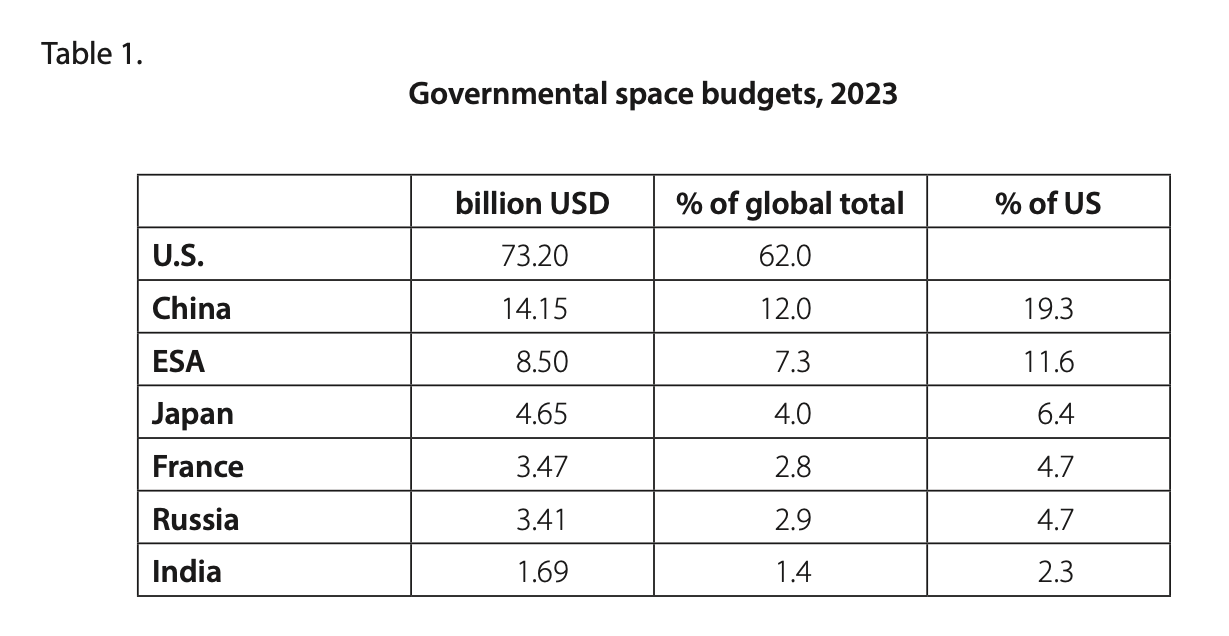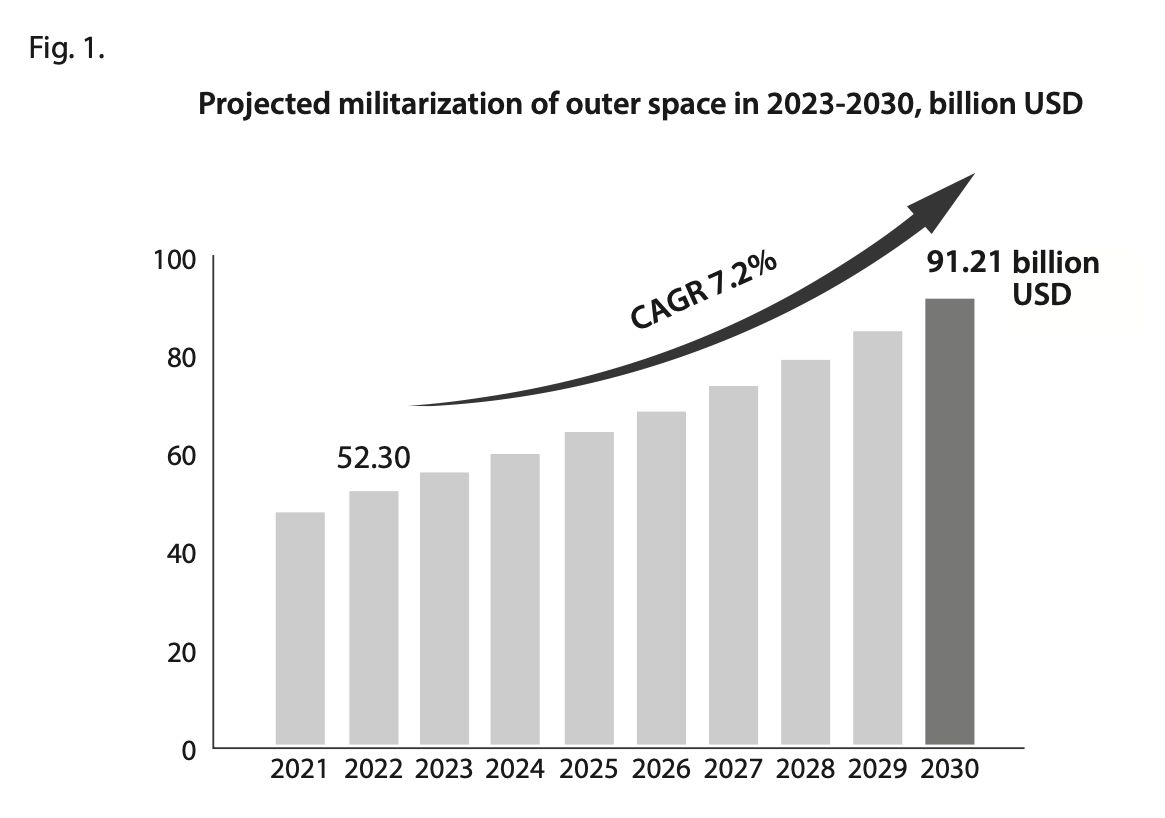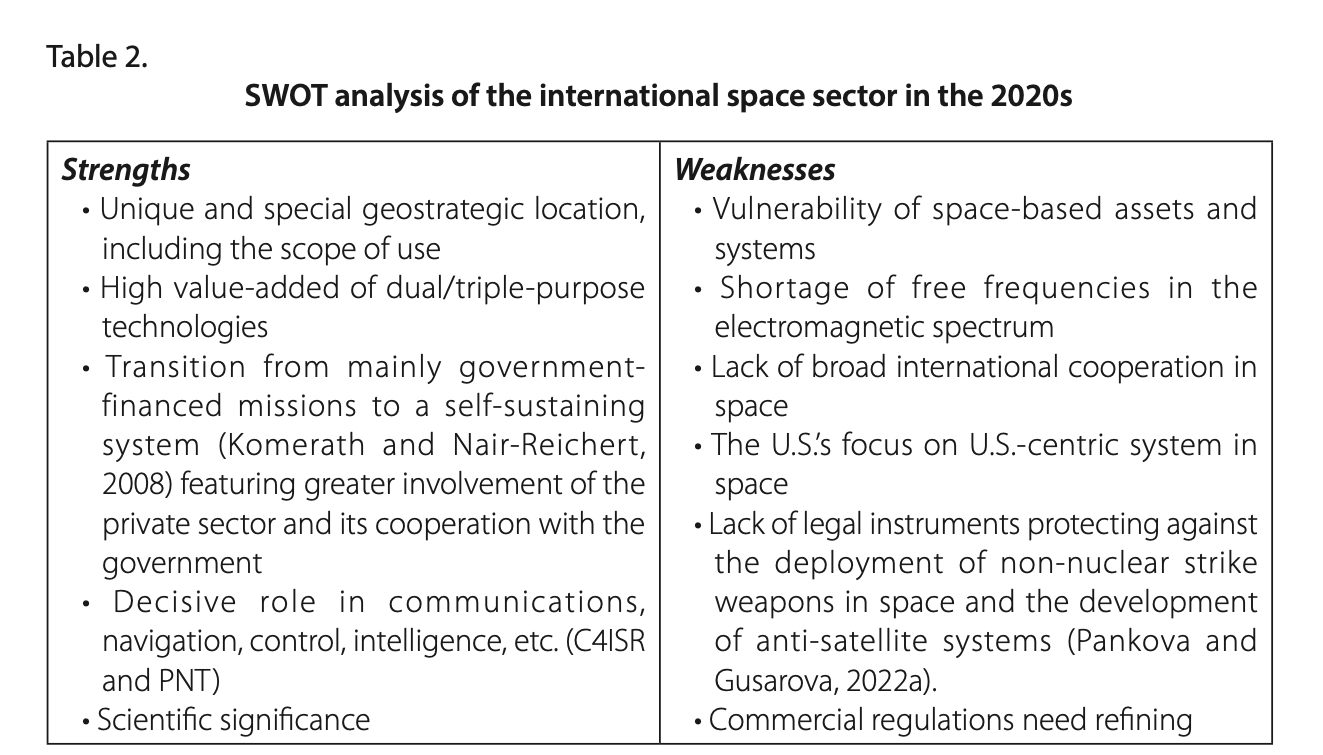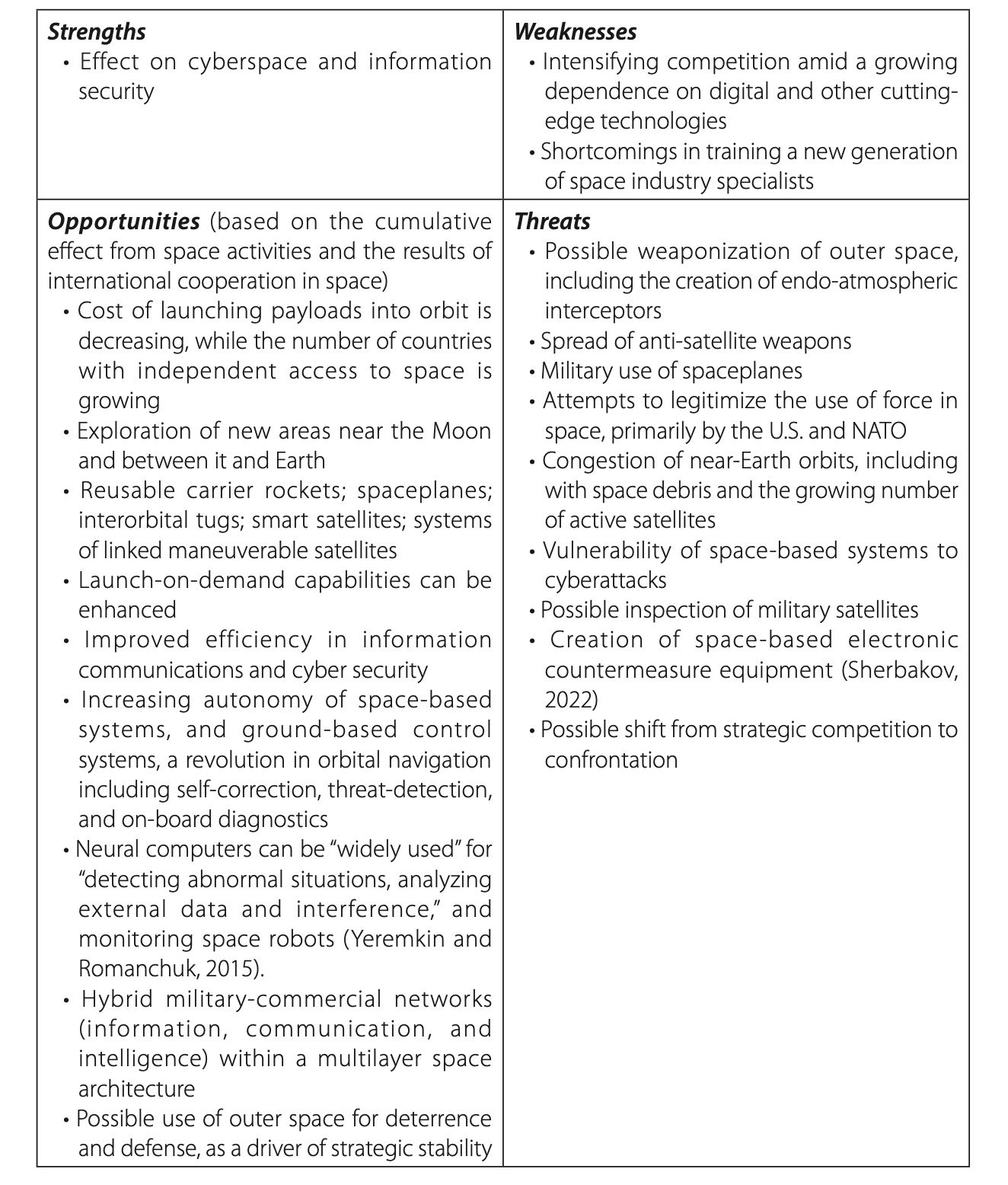For citation, please use:
Pankova, L.V. and Gusarova, O.V., 2025. From War to Commerce and Back. Russia in Global Affairs, 23(1), pp. 188–201. DOI: 10.31278/1810-6374-2025-23-1-188-201
Main Directions In Space Programs Around the World
Ninety countries were active in outer space in 2022-2023 (compared to 50 in the second half of the 2000s), of which 16 have independent access to space; 23 implement national space launch projects, including with the use of other countries’ cosmodromes; 28 have ground-based spaceports (which perform 99 percent of all space launches (Roberts, 2023)); and another 11 are building them (OECD, 2023). Almost 70 space agencies have been created (Steer, 2020; CERL, 2020; World Population Review, 2024), about half of them in the past 20 years, and the number of commercial space companies is increasing. As the capabilities of space-based systems improve, military and civilian (including commercial) demand for them is rising across the world. This process has been spurred partly by the declining cost of space payload delivery by U.S. companies.
As of June 2024, 10,019 satellites were in orbit (Tajikistan CA Agency, 2024), two-thirds of which belong to SpaceX; 90 percent are deployed in low Earth orbits; 8 percent in geostationary orbit, and 2 percent in medium and elliptical orbits (UCS Satellite Database, 2023). Multi-orbit services, providing links to satellites on different orbits, are being developed.
Independent access to space is important for national security. It requires rockets, spaceports, and data from C4ISR (Command, Control, Communications, Computers, Intelligence, Surveillance, and Reconnaissance) and PNT (Positioning, Navigation, and Timing) systems. One’s own satellite navigation system (e.g., the U.S.’s GPS, Russia’s GLONASS, China’s BeiDou, the EU’s Galileo) is also ideal.
Military and civilian (especially commercial) systems are becoming increasingly codependent, as illustrated by the U.S.’s “2024 DOD Commercial Space Integration Strategy,” leading to active ‘strategic competition’ (Sushentsov, 2020).
United States. The most prominent civilian projects are the multilateral Artemis lunar program, NASA’s plan for a nuclear reactor on the Moon by 2030 (Tonkin, 2022), and Boeing’s development of the X-37B spaceplane which, hopefully, will be successfully implemented despite reported finance problems. And, of course, we should mention the expansion of commercial space activities by U.S. SpaceX, Blue Origin, etc.
China. Key accomplishments include the landing of a spacecraft and lunar rover on the far side of the Moon (2019); the Tiangong permanently-crewed modular space station; and the first satellite using quantum communication. Chinese launches have sped up, from 19 launches using the Changzheng rocket in 2015 to 55 launches using Changzheng and commercial rockets in 2021 (Jones, 2022a). Work is underway to build China’s own spaceplane, and to set up solar power stations in low Earth (2028) and geostationary (2030) orbits (Jones, 2022b).
Russia. The following projects are currently planned or underway:
- A national space station by 2033.
- Multi-satellite systems such as Skif (12 satellites) and Marathon IoT (264) (TAdviser, 2024; TASS, 2022). Another one is planned in the largely-unoccupied very low Earth orbit of about 200 km (Vestnik GLONASS, 2023), thanks to the Ekipo corporation’s invention of atmosphere-fueled satellite engines.
- Small surveillance satellites (Aviation Explorer, 2022).
- Spaceplanes for the delivery of payloads into orbit.
- Reusable launch vehicles.
- The Zeus nuclear-powered interorbital space tug.[1]
- Lunar exploration. Alongside other countries, including China, Russia will participate in the International Lunar Research Station, scheduled for 2026-2035. It is planning a nuclear power plant for this project which is expected to be active in 2033-2035 (RIA Novosti, 2024).
The EU. The European Space Agency (ESA) has launched two projects (Genesis and LEO-PNT) within the FutureNav program to increase the stability and accuracy of navigation based on satellites in low Earth orbits (Parsonson, 2024).
Japan and its Aerospace Exploration Agency (JAXA) have also made significant progress in space exploration. Japan’s Basic Plan on Space Policy envisages four targets of Japan’s space activities: ensuring space security; contributing to disaster management, national resilience, and solving global issues; creating new knowledge through space science and exploration; and contributing to economic growth and innovative improvement. In 2024, Japan created the Space Strategic Fund of $6.7 billion for the next ten years (Japan, 2024).
India. The Indian Space Research Organization landed the Chandrayaan-3 craft near the Moon’s South Pole on 22 August 2023 (Jones, 2024), and is planning an orbital station by 2035 and a crewed Moon mission in 2040. India has its own launch systems, spaceport, and satellites.
Key Trends
The scale of space activities has increased dramatically for the first two decades of the 21st century. Due to the decreased cost of delivering payloads into near-Earth orbits (by about 95 percent for uncrewed missions and 75 percent for crewed ones) (Pankova and Gusarova, 2020a) and the development of new ambitious orbital and lunar projects, there are now 16 countries with independent access to space and 90 involved in space activities (up from 10 in 1970 and 50 in 2008 (The Space Economy in Figures, 2019)).
Satellites are now widely used in communication (including the Internet), navigation, control and management, surveillance, and other civilian and military sectors.
Private companies are increasingly involved, especially in the U.S.: SpaceX, as well as Blue Origin, Virgin Galactic, Rocket Lab, Astra Space, Astrobotic Technology, and others. So, space activities are being rapidly commercialized, facilitating the transition from mainly government-sponsored missions to “a self-sustaining system” (Komerath and Nair-Reichert, 2008).


According to our estimates, economic activity in space is growing faster than the global economy in general, having reached about 0.5 percent of it in 2021.
Space-based assets are playing a growing role in military operations, and the deployment of weapons into space—especially by the U.S. and NATO[2]—is a growing possibility. All major space powers have tested anti-satellite weapons and, at least partly for that purpose, are developing directed-energy, microwave, and electromagnetic-pulse technology, as well as countermeasures. Aerial warning systems are also being upgraded.
Accordingly, military cooperation in space is also being developed, especially by the U.S. with the rest of the Five Eyes (Australia, Canada, New Zealand, and the UK). The U.S. concluded Enhanced Space Cooperation Memoranda of Understanding with the UK in April 2022 (Erwin, 2022) and Canada in March 2023 (New Space Economy, 2024).
The decreasing cost of payload delivery has spurred the development of ambitious space projects, primarily lunar ones, as well as orbital and lunar stations.
The abovementioned trends are expanding, and are marked by a noticeably growing interconnection between economic issues and security problems.
Space Economics
The military issues of outer space are increasingly intertwined with economic ones. The space economy has been on the rise since around 2000, driven by government space programs, the entry of private businesses into value chains, the digital transformation, and technological advances (The Space Economy in Figures, 2019).
As of 2023, estimates of the space economy’s size ranged from $570 billion (Space Foundation, 2024) to $630 billion (McKinsey, 2024). It has been projected to reach $1.8 trillion by 2035 (McKinsey, 2024), and $2.7 trillion (Bank of America) or $3 trillion (Goldman Sachs) by 2040. Annual growth is projected at 6.84 percent for 2022-2026 (SpaceNews, 2022), and at 4.3 (UBS), 6 (U.S. Chamber of Commerce), 9 (Bank of America), or 9.5 percent (Goldman Sachs) for 2022-2026.
The space sector is shifting from government predominance to a mixed public-commercial “self-sustaining system” (Komerath and Nair-Reichert, 2008), in which cooperation between businesses, the state, and academia is increasingly important (Red Kite Management Consulting, 2021). Experts predict that private sector innovations will be the primary source of competitive advantage (Cahan and Sadat, 2021). But the state will continue to play a major role, primarily as a regulator and a stable contractor, providing organizational, financial, and legislative support (Markets and Markets, 2023).
Government funding for space programs (Table 1) is increasing: $52 billion worldwide in 2008; $75 billion in 2017 (The Space Economy in Figures, 2019), $92 billion in 2020 (a record, despite COVID-19), $103 billion in 2022 (Broadcast Pro., 2022), and $117 billion in 2023 (a 15% increase from 2022) (Euroconsult, 2023).
The U.S.’s share of spending fell from 75 percent in 2000 to 62 percent in 2023, while Asian countries’ share nearly doubled in the same period. But the U.S. still accounts for 68 percent of all satellites in orbit (of which more than 91 percent are commercial) (UCS Satellite Database, 2023), and (for now) retains the lead over China in lunar exploration. Americans account for 63 percent of all employees engaged in space activities in the U.S., Russia, the ESA, and Japan. Washington will try to make every effort to maintain its leadership, including, most likely, through sanctions. (Euroconsult, 2023).

At the end of the last century, funding, infrastructure, and general technological development were the necessary conditions for successful space exploration. However, in the 2020s, innovative digital technologies are a necessary but no longer sufficient condition. Rapid development requires alliances between states and between the manufacturers and users of space technology. China has already signed over a hundred cooperative space exploration agreements with more than three dozen countries and four international organizations (Defense Intelligence Agency, 2019). The U.S. is also pursuing partners not only for Artemis, but also for the abovementioned military-space alliances (Moltz, 2019). Cislunar space (between Earth and the Moon) has come under particular focus.
Security
Space’s military use is not new, but it is becoming more intense (Wehtje, 2023).
Many leading spacefaring nations have set up military branches dedicated to outer space. That of the U.S. has already arguably become critical to its national security (Cahan and Sadat, 2021).
NATO has also paid growing attention to space. Its overarching Space Policy (NATO, 2019)—published in 2019 and updated in 2024—views outer space as an “operational domain, which will help to ensure a coherent approach to the integration of space into NATO’s overall deterrence and defense posture” (NATO, 2019). NATO intends to serve as a “forum for military-political consultations and information sharing on relevant deterrence and defense-related space developments” (NATO, 2019). The U.S. and NATO are seeking to strengthen allied relations in the interests of the U.S. and eventually create a U.S.-centric system in space.


In 2023, military spending ($59 billion) for the first time became the majority of government space spending ($117b) (Euroconsult, 2023). The U.S. accounted for the overwhelming majority of this ($38.9b), followed by China ($8.8b), Russia ($2.6b), France ($1.3b), and Japan, the UK, the EU, and Germany with over $500 million each. The market research company S&S Insider projects global military space activities to exceed $91 billion by 2030 (Fig. 1).

Source: SNS INSIDER. “Space Militarization Market Size, Share & Segmentation by Capability (Support, Defense), By Solution (Ground-based Equipment, Space-based Equipment, Logistics & Services), By Regions & Global Forecast 2024-2032”. August 2023. Available at: https://www.snsinsider.com/reports/space-militarization-market-3633
Note: CAGR = compound annual growth rate.
In 2024, the U.S. allocated $30 billion to the Space Force, $3.7 billion more than in 2023. Almost 80 percent of this is for R&D and procurement, the remaining 20 percent for personnel and operations.
Space’s militarization is driven by geopolitics, national security, technological advances, and military modernization (Markets and Markets, 2023). The military use of C4ISR and PNT systems has become especially obvious in the Ukraine conflict.
Digital innovations are crucial in the competition between the leading space powers. These innovations include both emerging technologies (AI, machine learning, quantum technologies, etc.) and advances on traditional ones (improved sensors, directed-energy systems, electronic countermeasures, etc.) (Pankova and Gusarova, 2022c).
The militarization of space is harmful for sustainability, as it increases the amount of space debris (through the tests of rockets and anti-satellite weapons). Space Situational Awareness is thus increasingly important, with the main role played by advanced sensors on satellites, ground-based telescopes, or special space observation platforms.
* * *
The complexity of space activities in the 2020s opens up both opportunities and threats (see Table 2).


Both the opportunities and dangers arising from growing space activities require collective efforts to improve existing, and draft new, international treaties on the exploration and use of space, and develop measures to prevent its militarization. Unless urgent international legal issues are resolved, a space conflict will remain quite likely.
The accelerating polycentricity of global astronautics necessitates constant development of a strategic vision of future international space activities—for example, within the framework of the World Space Foresight Initiative (ICFI) (Pankova, 2019) to be based on the development of national space foresight initiatives.
[1] A space tug is a type of spacecraft used to transfer spaceborne cargo from one orbit to another orbit with different energy characteristics. An example would be moving a spacecraft from a low Earth orbit (LEO) to a higher-energy orbit like a geostationary transfer orbit, a lunar transfer, or an escape trajectory.
[2] This is evidenced, in addition to the development by the U.S. of directed-energy (laser, beam) and electromagnetic-pulse weapons, by its refusal to sign the UN resolution on the Prevention of Arms Race in Outer Space. Instead, the U.S. proposes to prevent the deployment of nuclear arms in outer space only.
_________________________
Aviation Explorer, 2022. Юрий Борисов: Россия обладает всеми мощностями для серийного изготовления спутников [Yuri Borisov: Russia Has All Necessary Capabilities to Produce Satellites Serially]. Aviation Explorer, 17 November. Available at: https://www.aex.ru/fdocs/2/2022/11/17/33189/?ysclid=lzsbj4nvhg818854276 [Accessed 1 October 2024].
Broadcast Pro., 2022. Global Governments’ Space Budget Reaches $103bn in 2022: Euroconsult. Broadcast Pro, 15 December. Available at: https://www.broadcastprome.com/news/satellite/global-governmentsa%C2%92-space-budget-reaches-103bn-in-2022-euroconsult/ [Accessed 1 October 2024].
Cahan, B. and Sadat, M.H., 2021. U.S. Space Policies for the New Space Age: Competing on the Final Economic Frontier. New Space Nexus, 6 January. Available at: https://www.newspacenexus.org/wp-content/uploads/2022/09/US-Space-Policies-for-the-New-Space-Age-Competing-on-the-Final-Economic-Frontier-010621-final.pdf [Accessed 1 October 2024].
Countries with Space Programs, 2024. World Population Review. Available at: https://worldpopulationreview.com/country-rankings/countries-with-space-programs [Accessed 1 October 2024].
Defense Intelligence Agency, 2019. Challenges to Security in Space. Defense Intelligence Agency January. Available at: https://aerospace.csis.org/wp-content/uploads/2019/03/20190101_ChallengestoSecurityinSpace_DIA.pdf [Accessed 1 October 2024].
Erwin, S., 2022. US-UK Special Relationship Deepens in Space. Space News, 18 July. Available at: https://spacenews.com/us-uk-special-relationship-deepens-in-space/ [Accessed 1 October 2024].
Euroconsult, 2023. New Historic High for Government Space Spending Mostly Driven by Defense Expenditures. Euroconsult, 19 December. Available at: https://www.euroconsult-ec.com/press-release/new-historic-high-for-government-space-spending-mostly-driven-by-defense-expenditures/ [Accessed 1 October 2024].
Japan, 2024. Japan Creates Multibillion-Dollar Space Strategic Fund to Boost Space Industry. Spacenews. 12 March. Available at: https://spacenews.com/japan-creates-multibillion-dollar-space-strategic-fund-to-boost-space-industry/ [Accessed 1 December 2024].
Jones, A., 2022a. China Looks to Launch Liquid Propellant Rockets from the Seas. Space News, 30 June. Available at: https://spacenews.com/china-looks-to-launch-liquid-propellant-rockets-from-the-seas/ [Accessed 1 October 2024].
Jones, A., 2022b. China Aims for Space-Based Solar Power Test in LEO in 2028, GEO in 2030. Space News, 8 August. Available at: https://spacenews.com/china-aims-for-space-based-solar-power-test-in-leo-in-2028-geo-in-2030/ [Accessed 1 October 2024].
Jones, A., 2024. India Targets a Surge in Civil and Commercial Launches. Space News, 16 February. Available at: https://spacenews.com/india-targets-a-surge-in-civil-and-commercial-launches/ [Accessed 1 October 2024].
Kolentsova, О., 2022. Атмосферный слой: российские спутники смогут летать без топлива [Atmospheric Layer. Russian Satellites May Become Non-Fuel]. Izvestia, 11 August. Available at: https://iz.ru/1374786/olga-kolentcova/atmosfernyi-svoi-rossiiskie-sputniki-smogut-letat-bez-topliva [Accessed 1 October 2024].
Komerath, N. and Nair-Reichert, U., 2008. Economic Interaction Modeling for a Space Economy. American Institute of Aeronautics and Astronautics, September. Available at: https://www.researchgate.net/publication/266882246_Economic_Interaction_Modeling_for_a_Space_Economy [Accessed 1 October 2024].
Markets and Markets, 2023. Space Militarization Market. Markets and Markets, June. Available at: https://www.marketsandmarkets.com/Market-Reports/space-militarization-market-145370586.html [Accessed 1 October 2024].
McKinsey, 2024. Space: The $1.8 Trillion Opportunity for Global Economic Growth. McKinsey & Company, 8 April. Available at: https://www.mckinsey.com/industries/aerospace-and-defense/our-insights/space-the-1-point-8-trillion-dollar-opportunity-for-global-economic-growth [Accessed 1 October 2024].
Moltz, J., 2019. The Changing Dynamics of Twenty-First Century Space Power. Journal of Strategic Security, 12(1), pp. 15-43.
Morgan Stanley, 2020. Space: Investing in the Final Frontier. Morgan Stanley. Available at: https://www.morganstanley.com/ideas/investing-in-space [Accessed 1 October 2024].
NATO, 2019. NATO’s Overarching Space Policy. NATO, 27 June. Available at: https://www.nato.int/cps/en/natohq/official_texts_190862.htm?selectedLocale=us [Accessed 1 October 2024].
New Space Economy, 2024. Beyond Borders: The Legal Framework Governing US-Canada Space Cooperation. New Space Economy, 25 March. Available at: https://newspaceeconomy.ca/2024/03/25/beyond-borders-the-legal-framework-governing-us-canada-space-cooperation/ [Accessed 1 October 2024].
OECD, 2023. The Space Economy in Figures: Responding to Global Challenges. OECD, 15 December. Available at: https://www.oecd.org/en/publications/the-space-economy-in-figures_fa5494aa-en.html [Accessed 1 October 2024].
Pankova, L., 2019. Worldwide Space Activity: Necessity of Strategic Foresight. AIP Conference Proceedings, 2171(1), pp.100001-1–100001-5.
Pankova, L.V. and Gusarova, O.V., 2020a. Космическое измерение инновационно-технологического прорыва [The Space Dimension of Innovative-Technological Breakthrough]. Mirovaya ekonomika i mezhdunarodnye otnosheniya, 64(11), p. 65.
Pankova, L.V. and Gusarova, O.V., 2020b. Научно-технологическая проекция космической деятельности [The Scientific-Technological Projection of Space Activities]. In: A.G. Arbatov (ed.) Контроль над вооружениями в новых военно-политических и технологических условиях [Arms Control in the New Military-Political and Technological Conditions]. Moscow :IMEMO RAN, p. 88.
Pankova, L.V. and Gusarova, O.V., 2022c. Мировая инновационно-цифровая экспансия: особенности момента {World Innovation-Digital Expansion: The Specificity of the Moment]. Vestnik RAN, 92(10), pp. 971-983.
Parsonson, A., 2024. ESA Awards €233M for Three Navigation Satellites. European Spaceflight, 20 Match. Available at: https://europeanspaceflight.com/esa-awards-e233m-for-three-navigation-satellites/ [Accessed 1 October 2024].
Red Kite Management Consulting, 2021. An International Comparison of Approaches to Space Cluster Development. Red Kite Management Consulting, 18 May. Available at: https://d11avd6t8zdcx0.cloudfront.net/uploads/2021/05/International-Comparison-of-Approaches-to-Space-Cluster-Development-Full-Report-Mar-21.pdf [Accessed 1 October 2024].
RIA Novosti, 2024. Россия начала разработку ядерной энергоустановки для лунной станции [Russia Launches the Development of Nuclear Power Station for the Lunar Station]. RIA Novosti, 8 May. Available at: https://ria.ru/20240508/ustanovka-1944583171.html?ysclid=lzgwz2p9lp889942394 [Accessed 1 October 2024].
Roberts, Th.G., 2023. Spaceports of the World. Aerospace Security, 31 January. Available at: https://aerospace.csis.org/data/spaceports-of-the-world/ [Accessed 1 October 2024].
Sherbakov, V., 2022. Невидимый щит и меч авиации [The Invisible Shield and Sword of Aviation]. Nezavisimoe voyennoe obozrenie, 32, p. 5.
Space Foundation, 2024. Space Foundation Announces $570B Space Economy in 2023, Driven by Steady Private and Public Sector Growth. Space Foundation. 18 July. Available at: https://www.spacefoundation.org/2024/07/18/the-space-report-2024-q2/ [Accessed 1 October 2024].
SpaceNews, 2022. Global $540+ Billion Space Economy Markets to 2026. Space News, 25 April. Available at: https://spacenews.com/global-540-billion-space-economy-markets-to-2026/ [Accessed 4 November 2024].
Steer, C., 2020. Why Outer Space Matters for National and International Security. CERL, University of Pennsylvania, 8 January. Available at: https://law.upenn.edu/live/files/10053-why-outer-space-matters-for-national-and-internional-security [Accessed 1 October 2024].
Sushentsov, А.А., 2020. О природе стратегической конкуренции России и США [On the Nature of Russia-U.S. Strategic Competition]. Valdai Club, 6 August. Available at: https://ru.valdaiclub.com/a/highlights/o-prirode-strategicheskoy-konkurentsii-rossii-i-ssha/?ysclid=lzlfhylxeh349549324 [Accessed 1 October 2024].
TAdviser, 2024. Roscosmos: Marathon Satellite System. TAdviser. Available at: https://tadviser.com/index.php/Product:Roscosmos:_Marathon_Satellite_System [Accessed 1 October 2024].
Tajikistan CA Agency, 2024. Tajikistan Civil Aviation Agency, 22 June. Available at: https://www.airnav.tj/ru/presscenter/int_news/1590-po-dannym-look-up-space-na-orbite-nahoditsya-10-000-aktivnyh-sputnikov.html [Accessed 1 October 2024].
TASS, 2022. Гендиректор ИСС Решетнева: мы разрабатываем пять спутниковых группировок для «Сферы» [ISS Director General Reshetneva: “We’re Developing Five Satellite Clusters for the ‘Sphere’”]. TASS, 11 November. Available at: https://tass.ru/interviews/16292261 [Accessed 1 October 2024].
Tonkin, S., 2022. NASA Wants to Put a Nuclear Reactor on the Moon by 2030: US Space Agency Shortlists Three Design Concepts That Could Turn Earth’s Satellite into an Orbiting Power Station. Mail Online, 24 June. Available at: https://www.dailymail.co.uk/sciencetech/article-10949091/NASA-wants-nuclear-reactor-moon—203.html [Accessed 1 October 2024].
The Space Economy in Figures, 2019. The Space Economy in Figures: How Space Contributes to the Global Economy. OECD, 5 July. Available at: https://www.oecd.org/en/publications/the-space-economy-in-figures_c5996201-en.html [Accessed 4 November 2024].
UCS Satellite Database, 2023. Union of Concerned Scientists, 1 May. Available at: https://www.ucsusa.org/resources/satellite-database#.W7WcwpMza9Y [Accessed 1 October 2024].
Vestnik GLONASS, 2023. В РФ могут создать низкоорбитальную группировку до 200 км. [Russia Can Build a Low-Orbit 200km Satellite Cluster]. Vestnik GLONASS, 28 August. Available at: http://vestnik-glonass.ru/news/vo_vlasti/v-rf-mogut-sozdat-nizkoorbitalnuyu-gruppirovku-do-200-km/ [Accessed 1 October 2024].
Wehtje, B., 2023. Increased Militarisation of Space – a New Realm of Security. Available at: https://behorizon.org/wp-content/uploads/2023/06/3_Militarization-of-Space.pdf [Accessed 4 November 2024].
Yeremkin, A.I. and Romanchuk, V.A., 2015. Применение нейрокомпьютерных технологий в военной промышленности [The Use of Neural Computing in the Defense Industry]. Sovremennye nauchnye issledovaniya i innovatsii, 6. Available at: https://web.snauka.ru/issues/2015/06/54110 [Accessed 1 October 2024].











